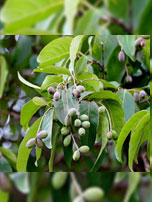SHAHEED KARTAR SINGH SARABHA AYURVEDIC MEDICAL COLLEGE & HOSPITAL
Affiliated to Guru Ravidas Ayurved University, Hoshiarpur Punjab
Affiliated to Guru Ravidas Ayurved University, Hoshiarpur Punjab

Botanical Name : Terminalia chebula Retz.
Family : Combretaceae.
Introduction :
It used for the management of dysurea and constipation, respiratory problems, certain skin disorders, eye diseases etc. The purgative principle is in the pericarp of the fruit.
Names in different Indian languages :
English : Chebulic Myrobalan, Black Myrobalan
Hindi : Harad, hara
Kannada : Harra, alaekayi
Malayalam : katukka
Sanskrit : Haritaki, pathya, abhaya
Tamil : katukkay
Telugu : Karakkaya, karitaki
Unani : Harad, Halelaa siyaah, Halelaa zard, Halelaa Kaabuli
Synonyms :
Kaayasthaa, Pathyaa, Shreyasi, Shivaa,Jivanti, Puutanaa,Vijayaa, Abhayaa, Rohini, Chetaki, Amritaa, , Jayã, Haimavati
Classification according to Charaka, Susrutha & Vagbhata :
Charaka
Jvaraghna, Arsoghna, Kãsaghna, Kusthaghna, Prajãsthãpana
Susrutha
Amalakyadi, Parusakädi, Triphalã
Vagbhata
Parusakãdi, triphala
Varieties & adulterants – (CV – controversy, AD – adulterants) :
1. Vijayã – sarva roga (all diseases)
2. Rohini – Vrana (wound healing)
3. Pütanã – Pralepa (external application)
4. Amrtã – purification procedures
5. Abhayã – Netra rogas (eye diseases)
6. Jivanti – Sarva roga (all diseases)
7. Cetaki. – Sarva roga (all diseases)
8. Niranjana
9. Vanaja
10. Parvatiya
11. T. pallida – South India (adulterant )
12. T. citrina – Assam(adulterant )
13. Baja haritaki
14. Chambhari haritaki
15. Survari haritaki
Morphology :
It is a large tree, with rust-coloured or silvery hairs over the younger branchlets etc.
Leaves- simple, mostly sub opposite, distant, ovate or oblong-ovate, 10-20 cm. long, deciduous in the cold season.
Flowers- dull-white or yellowish, with a strong offensive smell, in spikes from the upper axils and in small terminal panicles.
Fruits-obovoid or ellipsoidal from a broad base, glabrous, more or less 5-ribbed when dry.
(Flowers in April-May and fruits in November-January)
Distribution & Habitat :
Abundant in Northern India, also occurs in Bihar, West Bengal, Assam, Central India and South India.
Chemical constituents :
Shikimic, gallic, triacontanoic , palmitic acids, beta-sitosterol, daucosterol, chebulic acid , gallic acid, ellagitannin, terchebulin, punicalagin , teaflavin
Properties :
Rasa –Pañca rasa (except Lavana), Kasaya mainly
Guna -Laghu, Rüksa
Virya- Usna
Vipãka -Madhura
Majja – Madura rasa, snayu – amla rasa, patra – tikta rasa, twak – katu rasa, asthi – kasaya rasa
Karma : Tridosahara, Anulömana, Rasãyana, Prajãsthapãna, Caksusya, Hrdyã, Lekhana
Purgative, thermogenic, anti inflammatory, digestive, carminative, diuretic, anodyne.
Indication :
Prameha Kustha Vrana Chardi Vãtarakta Mütra Kricchra, Netra roga, Krimi, Hrdroga, Asmari, Klaibya, Kãsasvãsa etc
flatulence, constipation, fever, cephalgia, diarrhoea, dysentery, cyst, digestive disorders, cardiac disorder, vomiting, leprosy , enlarged liver and spleen, cough and bronchial asthma
Due to its ruksha properties, it should not be used in patient who am low, malnourished, debilitated, who have lost considerable amount of blood (through blood letting), and pregnant women.
Vijaya – in all diseases: rohini – used in healing of wounds: abhaya – in diseases of the eyes: jeevanti – useful in all diseases.
The fruit of haritaki contains five rasas
1) Madhur (sweet) – the fruit pulp.
2) Amla (sour) – the bulky portion of the fruit.
3) Tikta bitter) – seed.
4) Katu – the coveting of the fruit.
5) Kashaya (astringent) – the hard portion of the seed.
Thus haritaki is pancharasatmak. Haritaki is a medicinal herb yet the Ayurvedic texts emphasize the use of haritaki as a medicine which has to be taken regularly. Regularizing the normal functions of the body is also an important function of haritaki. Survari haritaki. chamhhari (or rangari) haritaki and bala haritaki are the types of haritaki used in practice.
Part used : Fruit
Dosage :
Leaf juice 10-15 ml
Powder 2-4 g
Decoction 50-100 ml
Internal uses :
Nervous System : Useful in weakness of the nerves and brain as well as in vata disorders and diminished vision.
Digestive System : Useful in loss of appetite, pain in the abdomen, constipation, gulma, ascites, haemorrhoids, hepatomegaly, splenomegaly and parasites. It relieves constipation in chronic abdominal diseases and also helps in digestion of “ama”. The bark of haritaki, if eaten after chewing it property in the mouth, improves digestion. Powdered haritaki reduces constipation. A fine powder of haritaki is used as a tooth powder. It strengthens the gums.
Circulatory system : Since haritaki is raktagami (exhibiting much action on rakta dhatu). it is used in weakness of the heart, vatarakta and other disorders of the blood.
Respiratory System : Rhinitis (due to constipation), cough, hoaziness of voice, hiccups and dyspnoea are relieved by haritaki as it reduces congestion:
Reproductive System : Useful in shukrameha, leucorrhoea and acts as a uterine tonic.
Urinary System : Useful in dysuria, retention of urine, calculus (Haritakyasthi siddha dugdha) and kaphaj prameha.
Skin : Useful in erysipelas and other skin disorders, haritaki prevents accumulation of pus in skin diseases and acts as a rasayana. Haritaki oil is extremely helpful in healing of wounds (especially in burns).
Temperature : Useful in typhoid fever and also chronic fever.
Restorative effect : Haritaki acts as a rejuvenator (by clearing the body of various malas). But for producing its rasayan effects, it needs various supportive drayas in different seasons, Varsha (monsoon) . saindhav, sharad – sugar, hemeint (winter) . sunthi, shishir – pippali, vasant (spring) – honey and greeshma (summer) Purgative induced by haritaki is relieved on its own. Baja haritaki is useful in haemorihoids. It helps in clearing the bowels.
Important Yogas or Formations :
Abhayädi modak, Abahayarishta, Pathyadivatl, Pathyadikadha, Waghrihalitald leha, Agastiharitaki leha, Gandharvaharitaki churna, Abhayarista, Kamsa Haritaki, Pathyádi kvãtha, Triphalã ctrna, Triphala ghiita, Citraka Haritakã, Vaivanara cürna, Harikakileha, Agastya Haritaki.
Therapeutic Uses :
(1) Ajirna- Haritaki is taken with Nimba (V.S.)
(2) Prameha- Haritaki powder should be given with honey (A.S.Ci.14).
(3) Amlapitta- Haritaki and Drãksã are taken together (V.M.)
(4) Upadamsa- Application of paste of Haritaki and Rasãñjana (R.M.)
